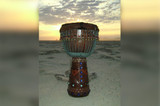Doumbek Essentials
The doumbek is a goblet shaped drum that comes in two main varieties: Egyptian and Turkish. It is a small drum, typically eighteen inches high. It is traditionally played by laying the drum on its side and placing it between the drummer’s arm and thigh, with the head resting in or just above the lap. The thigh you place it on depends on which is your dominant hand. Right-handed people should play the doumbek with it placed on their left thigh and left-handed people place it on their right thigh.
Mastering the doumbek can take many years. Like all drums, it requires dedication and focus to get the nuances and rhythms down pat. Fortunately, there are few doumbek essentials. There is the drum itself, learning the basic sounds, and understanding the timing. For beginners, the doumbek may provide an extra challenge because drummers may be learning a new genre of music. However, the drum is fun to play and once the rhythms are committed to memory, play is likely to progress more smoothly.
Doumbeks can be made of wood, ceramic, or metal. They can be plain, although many have ornate designs etched into them. While Egyptian doumbeks have a rounded edge, Turkish versions have exposed edges. Exposed edges can help with finger snaps, something that adds some panache when playing the drum. What a doumbek looks like, with regard to both materials and ornamentation, depends upon where it originates. Drum heads are typically made of goat skin or synthetic material.
The main doumbek essential to understand is the sound. The drum’s name comes from the “doum” and the “tek” sounds made when playing. There are actually three main sounds, “ka” being the third. Both the “doum” and “tek” sounds are made using the drummer’s dominant hand. The “ka” is essentially the “tek” made with the non-dominant hand.“Doum” is created by hitting the center of the head and pulling away quickly. “Tek” and “ka” use one or two fingers striking closer to the rim. “Ka” can also include hitting the drum’s shell and can be the most difficult of the three sounds to master due to arm placement. Sounds can also be created on the doumbek by using a stick, finger snaps, and a variety of other methods that bring the drum to life.

Timing is the final doumbek essential. It is important for anyone who wants to master the drum to memorize some basic rhythms. The doumbek, like many drums, provides inspiration for dancers. If a drummer would like to play for dancers, it would be necessary to have rhythms memorized so that when dancers want variety it is available to them. The doumbek is a drum that appeals on several levels and mastery is a pleasant sight to behold.
Recent Posts
-
What is the Best Size Djembe for Beginners?
If you're new to the world of percussion and interested in learning the djembe, you're in for a t …16th Jul 2024 -
The Benefits of Becoming a Drumming Teacher: Transforming Passion into Profession
Why become a drumming teacher? Becoming a drumming teacher is an excellent way to share your pas …22nd May 2024 -
What Makes the Djembe Drum a Spiritual Instrument in African Music?
Origin and history of the Djembe drum The Djembe drum originates from West Africa and holds sign …16th May 2024




